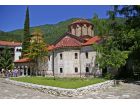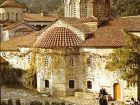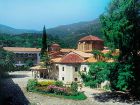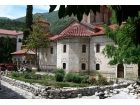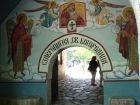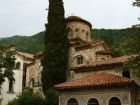Bachkovo Monastery
Bachkovo Monastery
The monastery was founded in 1083 by the Byzantine military commander of Georgian origin, Grigorii Bakuriani and his brother Abazii.
Yet only the two-storey bone-vault, which lies about 300m to the east of the present-day complex, is still kept from that time.
The bone-vault is a must-see building there, for its unique wall-paintings, which rank among the most valuable works of Orthodox art of the 11th –12th c.
During the times of the Second Bulgarian State, the monastery was patronised by Tsar Ivan Alexander, a portrait of whom can be still seen in the arcs of the bone-vault’s narthex due to his renovation of this building.
At the end of the 11th century, the monastery opens a religious school.
A curious fact is that after the subjection of Bulgarian lands to the Ottoman empire at the end of the 14th century, the Bulgarian Patriarch, Evtimii, was sent on exile here in the monastery.
Nevertheless, the exile did not dishearten the Patriarch and he, together with his scholars, developed active religious and cultural activity behind the walls of the monastery.
Even if the Bachkovo monastery survived the first coup of the Ottoman invasion, it was not spared later one and similarly to other cloister, was raided and ruined down.
It was restored towards the end of the 15th century with the dining hall having been reconstructed in 1601, and the present-day church, Virgin Mary, – in 1604.
The wall-paintings of the dining hall, finished in 1603 by an unknown master, are particularly impressive for their artistic value.
The church, on the other hand, also boasts with beautiful frescoes, but what draws mostly on visitors is its icon of Virgin Mary, believed to be wonder-working.
A long queue of pilgrims wishing to say their prayers to the miraculous image of the God’s Mother, often starts far outside the entrance of the church.
Besides the main church, the complex also has two smaller shrines: one called St Archangels (13th - 14th c.) and standing in the northern part of the inner yard (next to the main church) and another one, named after St Nikola (1834-1837).
The St Nikola church rises in the southern part of the yard and is worth visiting for the well-kept paintings of the famous artist Zahari Zograf (including a portrait of the very artist himself), finished in 1841.
The monastery also has its own museum which holds rare religious items of different times.





